It looks like you're using an Ad Blocker.
Please white-list or disable AboveTopSecret.com in your ad-blocking tool.
Thank you.
Some features of ATS will be disabled while you continue to use an ad-blocker.
share:
At first glance, The Giant's Playground in Nambia appears to be the ruins of an ancient man-made structure, but is actually a natural formation
caused by erosion. It's easy to see where the name "The Giant's Playground" came from.
One of my reasons for starting this thread, other than the simple beauty of the site, is to point out that many ancient man-made structures were made of dolerite, basalt, and similar types of stone, and many people wonder at how some of the pieces fit together so well. As can be easily seen in the following pictures and videos, in places such as The Giant's Playground, some of the hard work was done by nature, and would have allowed ancient people to move and restack the stones together to create their structures. Of course, much stone work would have still been needed, but I'm sure that they would have taken advantage of using stones such as those found at Giant's Playground to eliminate as much work as possible.
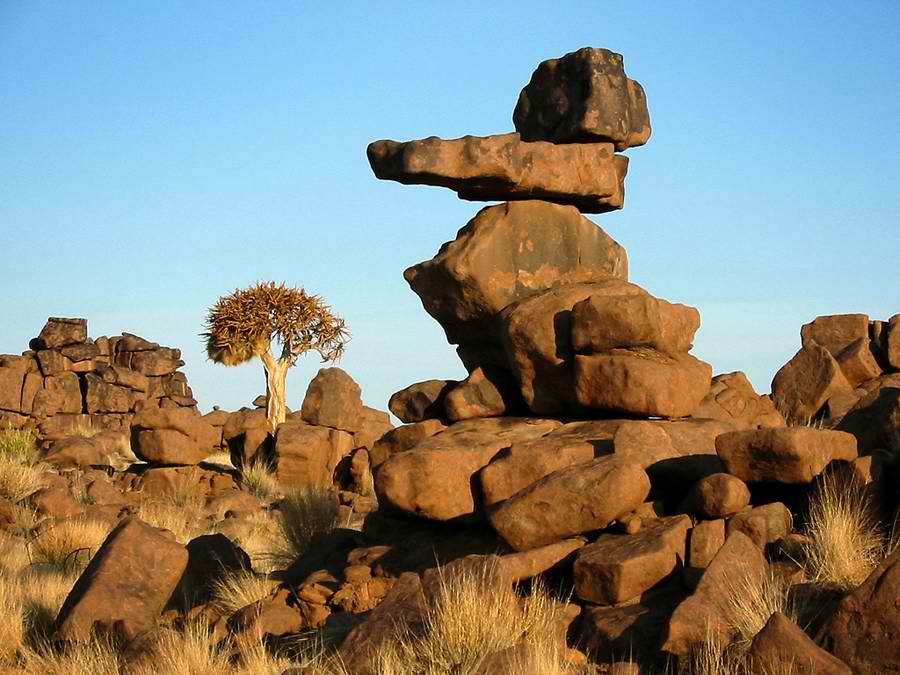
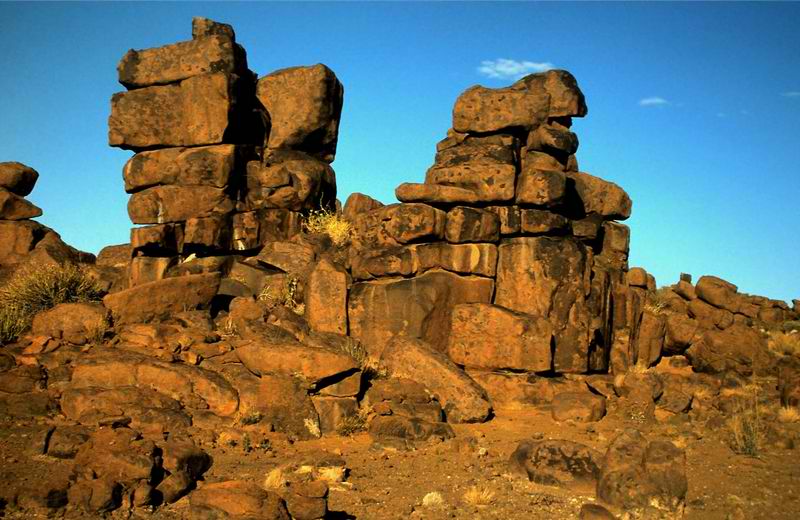
albatros-africa.com...
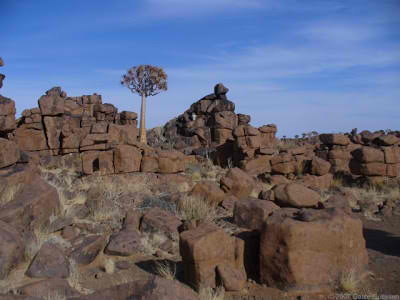
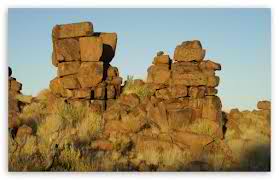
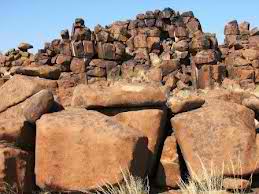
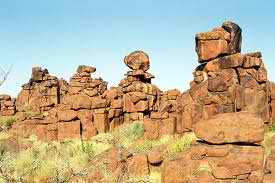
A very good panoramic view of The Giant's Playground can be found below:
www.gigapan.com...
www.namibia-1on1.com...
paulderphotograph.npage.de...
www.quivertreeforest.com...
Also, located in the same area of Nambia is the Quivertree Forest

en.wikipedia.org...
One of my reasons for starting this thread, other than the simple beauty of the site, is to point out that many ancient man-made structures were made of dolerite, basalt, and similar types of stone, and many people wonder at how some of the pieces fit together so well. As can be easily seen in the following pictures and videos, in places such as The Giant's Playground, some of the hard work was done by nature, and would have allowed ancient people to move and restack the stones together to create their structures. Of course, much stone work would have still been needed, but I'm sure that they would have taken advantage of using stones such as those found at Giant's Playground to eliminate as much work as possible.


albatros-africa.com...
Not far from the Quivertree Forest is the Giant’s Playground. Here, mighty dolerite and basalt rock formations balance precariously one on top of another to form what looks like a giant geometrical puzzle. These have stood here for around 180 million years and, combined with the Quivertree Forest, make for a very photogenic excursion.
The unusual rock formations were caused by the erosion of underling sedimentary rock around 170 million years ago.




A very good panoramic view of The Giant's Playground can be found below:
www.gigapan.com...
www.namibia-1on1.com...
paulderphotograph.npage.de...
www.quivertreeforest.com...
Also, located in the same area of Nambia is the Quivertree Forest

en.wikipedia.org...
The Quiver Tree Forest (Kokerboom Woud in Afrikaans) is a forest and a well-known tourist attraction of southern Namibia. It is located about 14 km north of Keetmanshoop, on the road to Koës, in the Gariganus farm. It comprises about 250 specimens of Aloe dichotoma, a species of aloe that is also locally known as "quiver tree" (Afrikaans: kokerboom) because bushmen use its branches to make quivers. The forest is spontaneous; the tallest quiver trees are two to three centuries old. The forest was declared a national monument of Namibia on June 1, 1995.
In the surroundings of the forest there is another site of geological interest (itself a tourist attraction), the Giant's Playground, a vast pile of large dolerite rocks.
This is a great point you are making here. Even the most naturally occurring things, albeit looking 'out of this world' are misconstrued as
something fantastical by people that would manipulate naive minds. Kudos for posting.
reply to post by isyeye
G,day mate. tks. really great pics. the first pic reminds me of some kind of squatting animal. have to say though, some of the pics could pass as places in aussie. the bush is so much better than frigging steel and glass people stackers (cities/buildings).
G,day mate. tks. really great pics. the first pic reminds me of some kind of squatting animal. have to say though, some of the pics could pass as places in aussie. the bush is so much better than frigging steel and glass people stackers (cities/buildings).
Cool pics. This is a good reminder that we need to look at things with balance. When we let our view become lopsided, we will always favor what we
want to be true. S&F.
edit on 2/13/2013 by Klassified because: (no reason given)
reply to post by boncho
Or.. Closed off minds can't open their eyes and see what is in front of them.
Or.. Closed off minds can't open their eyes and see what is in front of them.
Originally posted by FuzzyNintendo
reply to post by boncho
Or.. Closed off minds can't open their eyes and see what is in front of them.
Rocks. Big, eroded... Rocks.
Wooo...
Let's get to witch mountain!
reply to post by JayinAR
I agree with you. I've seen many fine examples of cyclopean architecture in South America. Those stacked blocks look like the same style to me. The telltale sign is the tight fit of the irregular shaped giant blocks. This building style is found all over the world and ruins date in the hundreds of thousands of years neighborhood! The most astounding thing to me is that even after all this time, a lot of those joints are still tight ... you can't even get a piece of paper into them. There was no motar used to set the blocks, but they did use metal cleats!
For more on cyclopean architecture check these links out:
www.experiencefestival.com... _masonry
daughterofcorn.blogspot.ca...
www.bibliotecapleyades.net... tm
davidpratt.info...
(just a few links... you could research this stuff for years )
I agree with you. I've seen many fine examples of cyclopean architecture in South America. Those stacked blocks look like the same style to me. The telltale sign is the tight fit of the irregular shaped giant blocks. This building style is found all over the world and ruins date in the hundreds of thousands of years neighborhood! The most astounding thing to me is that even after all this time, a lot of those joints are still tight ... you can't even get a piece of paper into them. There was no motar used to set the blocks, but they did use metal cleats!
For more on cyclopean architecture check these links out:
www.experiencefestival.com... _masonry
daughterofcorn.blogspot.ca...
www.bibliotecapleyades.net... tm
davidpratt.info...
(just a few links... you could research this stuff for years )
reply to post by Invariance
While I can easily understand how people could view places like this to be "stacked", they are only natural formations. There are many examples to be found in the world....and of the exact same stone type...they are called Dolerite Dykes.
This one below looks like a giant man-made wall, but again, it's a completely natural formation.
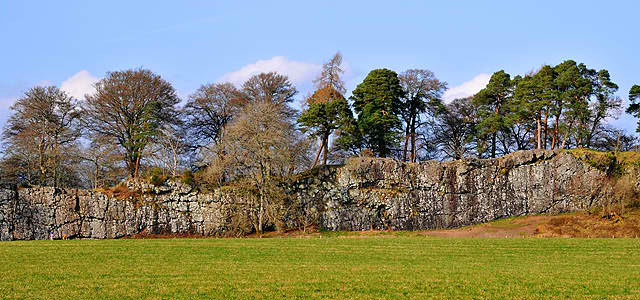
www.geograph.org.uk...
More examples:
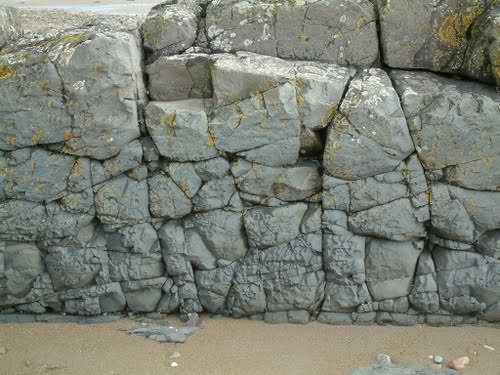
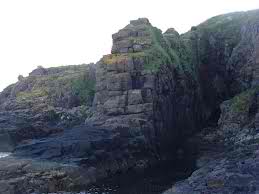
As I stated in my OP, I do believe that stones from places such as these were used to build megalithic structures, and partially explains how some of the stones fit together so well...natural helped the process.
While I can easily understand how people could view places like this to be "stacked", they are only natural formations. There are many examples to be found in the world....and of the exact same stone type...they are called Dolerite Dykes.
This one below looks like a giant man-made wall, but again, it's a completely natural formation.

This is one of a series of volcanic dykes caused by molten rock thrusting up through cracks in the crustal rocks: The solidified upwelling rock (in this case quartz-dolerite) is harder than the surrounding bedrock and weathers less over time leaving a cliff or wall of dolerite - Ideal for rock climbing
www.geograph.org.uk...
More examples:


As I stated in my OP, I do believe that stones from places such as these were used to build megalithic structures, and partially explains how some of the stones fit together so well...natural helped the process.
edit on 14-2-2013 by isyeye because: (no reason given)
Sorry, but your thesis simply does not stand up. The South American ancient cities have buildings made of stone cut to incredible accuracy and
interlocking in intricate ways that were meant to strengthen them against earthquakes. The blocks were consistently huge, not tiddly rocks of varying
size like those shown in your photos. So huge that archaeologists still cannot figure out how their builders cut and hoisted such heavy blocks to fit
together with such amazing accuracy with the simple tools that were supposed to have been available thousands of years ago. Just because you find
natural stone formations that looks like some of the buildings found in South America proves nothing. The quality of the latter is far beyond that of
the rough, crack-ridden boulders. And in most cases the buildings are not located in areas where there are lots of rocks close by. So the builders
could not have been merely improving upon natural rock formations by smoothing their rough edges, etc.
reply to post by micpsi
Look closely at the area within the red box in the picture below...notice how the stones "match" each other. What I am saying is that it would be perfectly natural and acceptable for ancient megalithic builders to take advantage of cracks and the natural formation of stones when assembling their structures. I'm not saying that they built them on the original sites of the stones, but transported them to the building site and re-assembled portions of the stones that fit together well.
As I've mentioned before, this is only a part of the process. Much stone work would have been needed to clean up the lines, and fit pieces together, but it would be completely possible, and most likey what they did to use stones that fit well together because of natural processes. Why would they go through all the unneed work to make two stones fit together when natural already made two other ones work naturally?
...and also, if you look closely...they did use varying sized stones throughout the walls...they used what worked together best to produce the strongest wall.
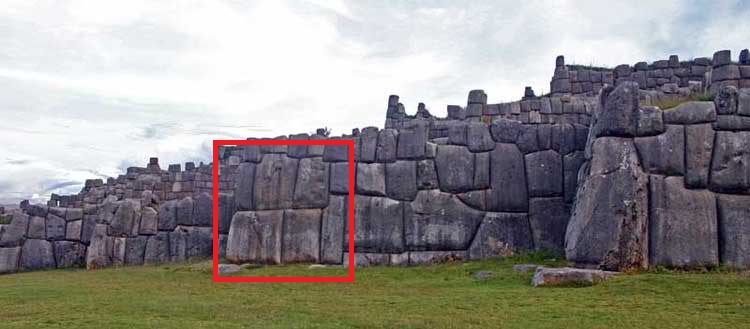
Look closely at the area within the red box in the picture below...notice how the stones "match" each other. What I am saying is that it would be perfectly natural and acceptable for ancient megalithic builders to take advantage of cracks and the natural formation of stones when assembling their structures. I'm not saying that they built them on the original sites of the stones, but transported them to the building site and re-assembled portions of the stones that fit together well.
As I've mentioned before, this is only a part of the process. Much stone work would have been needed to clean up the lines, and fit pieces together, but it would be completely possible, and most likey what they did to use stones that fit well together because of natural processes. Why would they go through all the unneed work to make two stones fit together when natural already made two other ones work naturally?
...and also, if you look closely...they did use varying sized stones throughout the walls...they used what worked together best to produce the strongest wall.

reply to post by micpsi
I must have missed where the OP is trying to claim this phenomenon is responsible for every controversial ancient site?
But sites like this are *very* well known to geology. It is a completely non-controversial mechanism of long-term processes. Big sturdy rocks dispersed randomly in weaker sediment, when subjected to thousands of years of steady erosion, (Or likewise big sturdy rocks locked into a glacier, when subjected to steady icemelt) WILL leave curious stacked designs like this. It's utterly futile and nonsensical to dispute it.
That said, this "erosion-stacking" is just one specific phenomenon and should not even be considered to be the mechanism responsible for a "possibly man-made ancient site" unless there are clear signs that this is the case.
I must have missed where the OP is trying to claim this phenomenon is responsible for every controversial ancient site?
But sites like this are *very* well known to geology. It is a completely non-controversial mechanism of long-term processes. Big sturdy rocks dispersed randomly in weaker sediment, when subjected to thousands of years of steady erosion, (Or likewise big sturdy rocks locked into a glacier, when subjected to steady icemelt) WILL leave curious stacked designs like this. It's utterly futile and nonsensical to dispute it.
That said, this "erosion-stacking" is just one specific phenomenon and should not even be considered to be the mechanism responsible for a "possibly man-made ancient site" unless there are clear signs that this is the case.
edit on 14-2-2013 by Son of Will because: (no reason given)
That does not look like natural erosion. I see structure, and placement. Reminds me of other megalithic structures around this planet. South America
specially. Almost like Puma-Punku.
reply to post by Son of Will
Nope, you didn't, because I don't claim such a thing...It's a completely natural formation, as you again illustrated. My suggestion is only that ancient megalithic stone workers would have taken advantage of these natural formations when selecting stones to work with, and use them in their structures.
I must have missed where the OP is trying to claim this phenomenon is responsible for every controversial ancient site?
Nope, you didn't, because I don't claim such a thing...It's a completely natural formation, as you again illustrated. My suggestion is only that ancient megalithic stone workers would have taken advantage of these natural formations when selecting stones to work with, and use them in their structures.
Sacsayhuaman always reminds me of a "stone wall" I came across on the coast of Jura
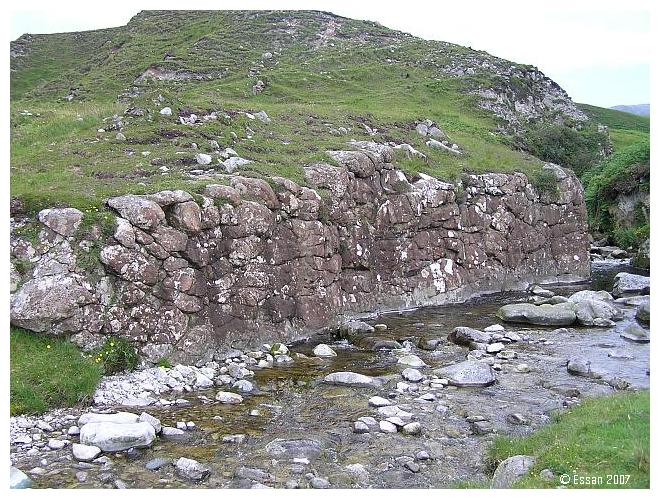
(actually another dolerite dyke)

(actually another dolerite dyke)
Originally posted by Oannes
That does not look like natural erosion. I see structure, and placement. Reminds me of other megalithic structures around this planet. South America specially. Almost like Puma-Punku.
Yea, as in Peru many places there looks 'destroyed', even melted down.
Just a few fast examples:
Of course in this case they say it's only a few hundred years old, while it almost looks as old as those millions of years old 'natural' stones in the poster example.
But sure i'm not counting out the openingsposter may be just natural but in my eyes it sure is still open for debate.
edit on 14-2-2013 by Plugin because: (no reason given)
reply to post by AndyMayhew
Broken up by war or cataclysmic happenings.probably why Mars looks like it dose war between planet with super high tech weapons a very long time ago.someone knows and there not telling us.maybe the cocky elite?I think they know.
Broken up by war or cataclysmic happenings.probably why Mars looks like it dose war between planet with super high tech weapons a very long time ago.someone knows and there not telling us.maybe the cocky elite?I think they know.
Originally posted by isyeye
reply to post by micpsi
Look closely at the area within the red box in the picture below...notice how the stones "match" each other. What I am saying is that it would be perfectly natural and acceptable for ancient megalithic builders to take advantage of cracks and the natural formation of stones when assembling their structures. I'm not saying that they built them on the original sites of the stones, but transported them to the building site and re-assembled portions of the stones that fit together well.
As I've mentioned before, this is only a part of the process. Much stone work would have been needed to clean up the lines, and fit pieces together, but it would be completely possible, and most likey what they did to use stones that fit well together because of natural processes. Why would they go through all the unneed work to make two stones fit together when natural already made two other ones work naturally?
...and also, if you look closely...they did use varying sized stones throughout the walls...they used what worked together best to produce the strongest wall.
Look closely at the area within the red box in the picture below...notice how the stones "match" each other. What I am saying is that it would be perfectly natural and acceptable for ancient megalithic builders to take advantage of cracks and the natural formation of stones when assembling their structures.
them cracks and 'natural formations' are not natural..... nature doesnt work in angles or straight lines.The time and effort it would take to place these stones by trial and error would be rediculous.
i personally think each stone was manipulated to fit the last,stone by stone.
The cracks inbetween the stones are so tight you cant even fit a knife blade in them.
This is how i think it was done...
&st82EHYTxNA
edit on 15-2-2013 by flana23 because: vid embedding
edit on 15-2-2013 by flana23 because: (no reason given)
and all this time people thought the giant cities of past were done by aliens or giants.
ha almost laughable now that we know they just melted into place like that......j/k
that place is too cool.
ha almost laughable now that we know they just melted into place like that......j/k
that place is too cool.
new topics
-
Gen Flynn's Sister and her cohort blow the whistle on DHS/CBP involvement in child trafficking.
Whistle Blowers and Leaked Documents: 11 minutes ago -
Anybody else using Pomodoro time management technique?
General Chit Chat: 2 hours ago -
Bucks County commissioners vote to count illegal ballots in Pennsylvania recount
2024 Elections: 5 hours ago -
Trump sues media outlets -- 10 Billion Dollar lawsuit
US Political Madness: 6 hours ago -
Fired fema employee speaks.
US Political Madness: 6 hours ago -
How long till it starts
US Political Madness: 7 hours ago -
USSS Agent Fired for Having Sex In Michelle Obama's Bathroom
Politicians & People: 9 hours ago
top topics
-
Trump sues media outlets -- 10 Billion Dollar lawsuit
US Political Madness: 6 hours ago, 21 flags -
Bucks County commissioners vote to count illegal ballots in Pennsylvania recount
2024 Elections: 5 hours ago, 17 flags -
How long till it starts
US Political Madness: 7 hours ago, 15 flags -
USSS Agent Fired for Having Sex In Michelle Obama's Bathroom
Politicians & People: 9 hours ago, 9 flags -
Fired fema employee speaks.
US Political Madness: 6 hours ago, 9 flags -
Watching TV
Jokes, Puns, & Pranks: 12 hours ago, 8 flags -
Anybody else using Pomodoro time management technique?
General Chit Chat: 2 hours ago, 2 flags -
Gen Flynn's Sister and her cohort blow the whistle on DHS/CBP involvement in child trafficking.
Whistle Blowers and Leaked Documents: 11 minutes ago, 0 flags
active topics
-
Trump sues media outlets -- 10 Billion Dollar lawsuit
US Political Madness • 30 • : xuenchen -
Gen Flynn's Sister and her cohort blow the whistle on DHS/CBP involvement in child trafficking.
Whistle Blowers and Leaked Documents • 2 • : Cloudbuster1 -
The Trump effect 6 days after 2024 election
2024 Elections • 132 • : Astrocometus -
Bucks County commissioners vote to count illegal ballots in Pennsylvania recount
2024 Elections • 12 • : soulrevival -
How long till it starts
US Political Madness • 10 • : Astrocometus -
The Guardian quits Elon Musk's X social media platform
Mainstream News • 19 • : burntheships -
Mike Tyson returns 11-15-24
World Sports • 45 • : DontTreadOnMe -
President-Elect DONALD TRUMP's 2nd-Term Administration Takes Shape.
Political Ideology • 198 • : WeMustCare -
WATCH LIVE: US Congress hearing on UFOs, unidentified anomalous phenomena
Aliens and UFOs • 82 • : putnam6 -
Turns out, they planned to go after P-nut.
US Political Madness • 41 • : AdultMaleHumanUK
